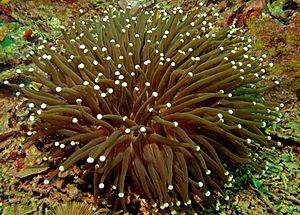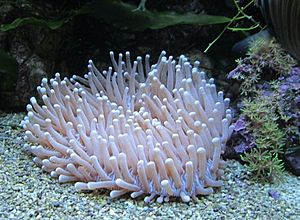Heliofungia actiniformis facts for kids
Quick facts for kids Heliofungia actiniformis |
|
|---|---|
 |
|
| Conservation status | |
| Scientific classification | |
| Synonyms | |
|
List
|
The Heliofungia actiniformis is a special type of coral often called a mushroom coral. It's a single, large stony coral that belongs to the family called Fungiidae. You can find this coral in shallow waters across the Indo-Pacific region. It's a zooxanthellate species, which means it has tiny helpers living inside it.
This coral is quite popular for reef aquariums. However, wild populations are facing threats from diseases, climate change, and too much collecting. Because of these dangers, the IUCN has listed it as a vulnerable species.
Contents
What is a Mushroom Coral?
When it's young, this coral attaches itself to the ocean floor. But as it grows up, it breaks free and lives on its own. It's usually round or oval, growing up to 20 centimetres (8 in) wide and 7 centimetres (3 in) tall.
The coral has a thick, strong stony skeleton inside, which is called a corallum. This skeleton has stony ridges called septa. The septa that form first are bigger and have more noticeable, bumpy or triangle-shaped teeth. All the septa are rough and continue as thin ridges on the underside of the coral, called costae. In the middle of its underside, there's a small scar from where it was once attached.
The coral's soft body, called a polyp, is thick and fleshy. It has one mouth surrounded by thick tentacles that have small knobs on their ends. These tentacles are almost always out, making the coral look a lot like a big sea anemone.
Where Do They Live?
Heliofungia actiniformis lives in the eastern Indian Ocean and the central Indo-Pacific area. You can find it along the coasts of northwestern, northern, and eastern Australia, as well as near Japan, the China Sea, and the islands of the West Pacific.
It usually lives in water between about 1 and 25 metres (3 and 82 ft) deep. You'll often spot it on the slopes of coral reefs or on flat reef areas.
How Do They Live and Grow?
H. actiniformis is a zooxanthellate coral. This means it has tiny plant-like helpers called photosynthetic, symbiotic organisms living inside its tissues. During the day, these tiny helpers use sunlight to make food, providing most of what the coral needs to live.
The coral also eats small ocean creatures called zooplankton. It catches these tiny animals with its tentacles. Besides making new corals by releasing eggs and sperm into the water, this coral can sometimes create a new polyp by budding off a small piece of itself.
The polyps of H. actiniformis also provide a home for many other animals. These can include cleaner shrimps and young fish.
Helping Corals Grow (Aquaculture)
Many corals can be grown by taking small pieces from a colony and attaching them to a new surface. However, this method doesn't work for large stony corals like Heliofungia actiniformis.
Scientists are hoping to grow these corals by collecting their eggs and sperm when they reproduce. They mix the eggs and sperm in special tanks and then raise the baby corals (larvae) in controlled conditions. This method has worked well for another coral called Acropora formosa.
The goal is to use these new corals to help damaged reefs grow back or to reduce the need to collect corals from the wild for the reef aquarium trade.
Why Are They Vulnerable?
Even though this coral is common in some places, it's at risk because coral reefs are facing many problems. It can get coral diseases and is sensitive to coral bleaching, which is when corals turn white and can die. Climate change is also a big threat.
This coral is also collected a lot for the aquarium trade. It's one of the top 10 corals exported from Indonesia, which is the biggest exporter of this species. In 2005, about 50,000 of these corals were collected and sent out from Indonesia. Because of all these reasons, the International Union for Conservation of Nature has decided that its conservation status is "vulnerable".
See also
 In Spanish: Heliofungia actiniformis para niños
In Spanish: Heliofungia actiniformis para niños



